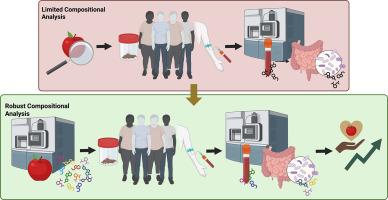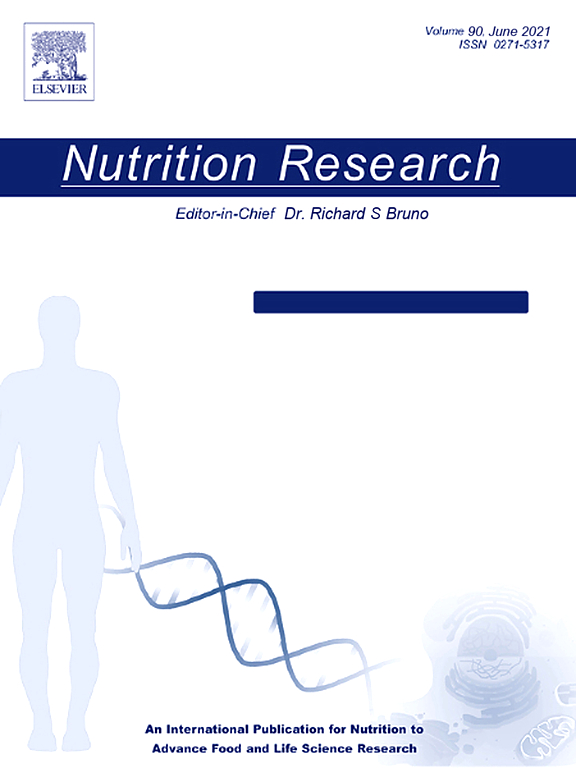Comparing apples to apples: Evaluating foodomics in precision nutrition research featuring the influence of polyphenols on the gut microbiome
IF 3.1
3区 医学
Q2 NUTRITION & DIETETICS
引用次数: 0
Abstract
This review aimed to evaluate the use of advanced omics methodologies in dietary intervention clinical trials investigating the influence of polyphenols on the gut microbiome. All published clinical studies in the Cochrane Library database from 2014 to 2024 containing the keywords “polyphenols” and “gut microbiome” were compiled and categorized based on experimental design, analytical methodologies, and findings. We found that despite known variability in food composition across agricultural and processing parameters, omics analysis of the food used in clinical nutrition interventions has not been widely embraced. None of the studies evaluated employed untargeted omics approaches for food composition analysis, while 5 of the 38 studies used untargeted omics for clinical samples analysis. Targeted analytical methods focused on known compounds or proxies were more commonly used for food composition analysis (18 of 38 studies) and clinical samples (24 of 38 studies), though analysis of clinical samples focused on a greater number of target compounds. Data from these studies support relationships between the gut microbiome, clinical outcomes, and specific metabolites. However, several studies highlight inconsistencies between their findings and previous literature, which may be attributed to unrealized differences in polyphenol composition. We propose that inclusion of comprehensive omics-based food composition analyses in dietary intervention clinical trials may increase study value by accounting for variability in food composition and enabling novel discovery. Such data would support the emerging fields of personalized and precision nutrition, aimed at understanding the influence of individual human characteristics on physiological responses to foods, nutrients, phytochemicals, and dietary patterns.

苹果与苹果的比较:以多酚对肠道微生物组的影响为特征的精确营养研究中的食物组学评估。
本综述旨在评估先进的组学方法在研究多酚对肠道微生物组影响的饮食干预临床试验中的应用。根据实验设计、分析方法和研究结果,对2014年至2024年Cochrane Library数据库中包含“多酚”和“肠道微生物组”关键词的所有已发表的临床研究进行汇编和分类。我们发现,尽管已知食品成分在农业和加工参数方面存在差异,但用于临床营养干预的食品组学分析尚未被广泛接受。被评估的研究中没有一项采用非靶向组学方法进行食品成分分析,而38项研究中有5项使用非靶向组学方法进行临床样本分析。针对已知化合物或替代品的针对性分析方法更常用于食品成分分析(38项研究中的18项)和临床样本(38项研究中的24项),尽管临床样本的分析侧重于更多的目标化合物。这些研究的数据支持肠道微生物组、临床结果和特定代谢物之间的关系。然而,一些研究强调了他们的发现与先前文献之间的不一致,这可能归因于未意识到的多酚成分的差异。我们建议在饮食干预临床试验中纳入全面的基于组学的食物成分分析,可以通过考虑食物成分的可变性和促进新发现来增加研究价值。这些数据将支持个性化和精确营养的新兴领域,旨在了解个人特征对食物、营养素、植物化学物质和饮食模式的生理反应的影响。
本文章由计算机程序翻译,如有差异,请以英文原文为准。
求助全文
约1分钟内获得全文
求助全文
来源期刊

Nutrition Research
医学-营养学
CiteScore
7.60
自引率
2.20%
发文量
107
审稿时长
58 days
期刊介绍:
Nutrition Research publishes original research articles, communications, and reviews on basic and applied nutrition. The mission of Nutrition Research is to serve as the journal for global communication of nutrition and life sciences research on diet and health. The field of nutrition sciences includes, but is not limited to, the study of nutrients during growth, reproduction, aging, health, and disease.
Articles covering basic and applied research on all aspects of nutrition sciences are encouraged, including: nutritional biochemistry and metabolism; metabolomics, nutrient gene interactions; nutrient requirements for health; nutrition and disease; digestion and absorption; nutritional anthropology; epidemiology; the influence of socioeconomic and cultural factors on nutrition of the individual and the community; the impact of nutrient intake on disease response and behavior; the consequences of nutritional deficiency on growth and development, endocrine and nervous systems, and immunity; nutrition and gut microbiota; food intolerance and allergy; nutrient drug interactions; nutrition and aging; nutrition and cancer; obesity; diabetes; and intervention programs.
 求助内容:
求助内容: 应助结果提醒方式:
应助结果提醒方式:


